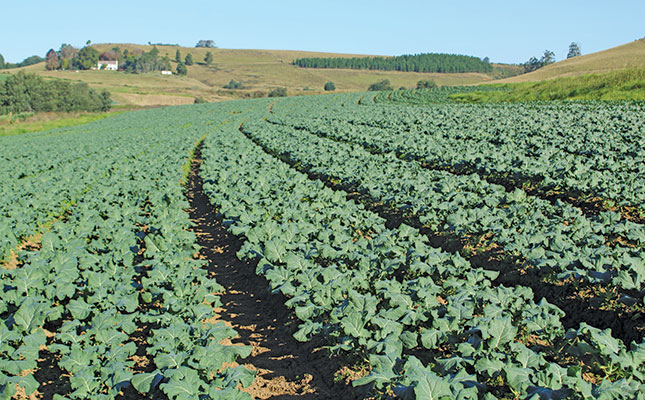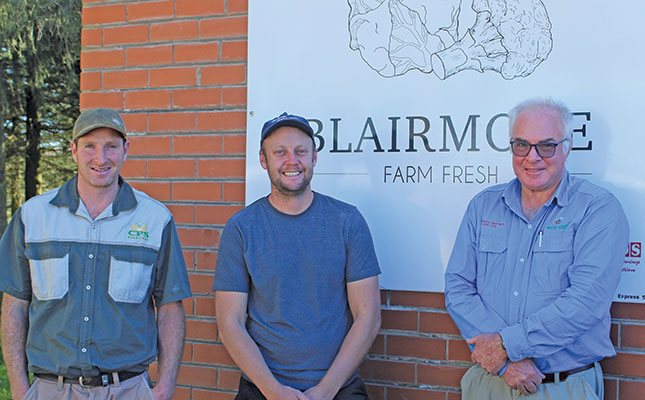
Photo: Lindi Botha
The 40ha of cauliflower and broccoli crops stretches out over the picturesque hillside in Curry’s Post, KwaZulu-Natal. You would be forgiven for thinking the vista has been staged, for it’s not only the setting that’s picture perfect, but the crops themselves.
Uniform to the point of perfection, the plants all stand at an equal height, leaves thick and lush, with hardly a blemish in sight.
Yet Southern Block farm carries out only a tenth of the pest-control applications that their neighbouring farm does. “If all the nutrients are in balance and the plant sap is optimal, pests find it difficult to bite into the thick leaves,” explains Rory Milbank, the farm’s agronomist.
Taking a natural approach is at the heart of the farm’s success, and getting the soil in top shape is an ongoing process, albeit one that requires less and less human intervention as time goes on.
When James Kelly took ownership of the farm in 2019, he faced the task of converting the existing dairy pastures into vegetable lands. Since there was a good market demand for Brassica crops, he made this his focus.
He called on Rory’s experience, and the pair set about making corrections to the soil. “To generate biodiversity in the soil, we use only organic nutrients. Correcting soil is a lot easier than you think; you just need to stop killing the micro-organisms!

We only add that which has a symbiotic relationship with the soil and doesn’t have a negative impact on the micro-organisms. Once you create this environment, the soil sorts itself out. I just need to make sure that I provide the micro-organisms with enough food to flourish,” explains Rory.
He notes that few substances are more nutritious to micro-organisms than the sugars given off by plant roots. “So by planting a crop, we’re also feeding our soil. This greatly reduces the nitrogen requirement, which is good for the plants as well as the budget.”
Rory has walked a long road to become the biological farming convert he is today. “I’m part of the ‘lost generation’ who were indoctrinated to use harsh chemicals and nitrogen to get a crop off the ground. When I asked my university professors about a more biological [approach], I was told there was no room for ‘bunny huggers’.
“So I walked the way many farmers are still walking today, and the result was depleted soils with nutrient imbalances that were difficult to fix, and yields that decreased. I reached a point where I just couldn’t keep going with the high input costs and low yields, and was forced to look for an alternative way.”
Rory jests that he has paid the school fees for his son, farm manager Warren Milbank, as well as James, both of whom have only ever farmed biologically and know the success it brings. James admits that his generation has also benefitted from the wealth of information they have access to.
“The availability of technology like podcasts plays a big role in how we farm and solve problems. This has resulted in a greater shift towards biological farming worldwide, because people who are seeking answers to problems can find solutions that work.”
For Southern Block farm, the proof of biological farming’s effectiveness lies in the soil, where a combination of organic fertiliser and beneficial bacteria work to produce robust crops that need less intervention year by year.
Building the soil
An essential tool used by the team has been the organic fertiliser they source from Talborne Organics.
“We have very few aphid problems because we eliminate the use of nitrates,” explains Rory.
“Nitrates dilute the sap of the plants and lower the Brix level, making the crop more susceptible to aphids. Our Brix levels are around 12, far higher than the average of seven, which is where plants become very vulnerable.”
The fertiliser mixture is custom-made and contains nutrients at levels determined by soil analysis. Care is taken to apply only what is deficient.
Warren explains that his focus is on minerals that increase photosynthesis: manganese, iron, magnesium, nitrogen and phosphates.
“The nitrogen, however, is in amino acid form, not nitrates, which is far healthier for the soil. I also asked for diatomaceous earth to be added to the mix, the silica of which is absorbed into the plant, improving the cell structure and strengthening the crops. When the diatomaceous earth was first added, I noticed that the leaves of the broccoli and cauliflower became thicker and waxy.”
As the fertiliser pellets ensure a slow release of nutrients into the soil, no top-ups are required during the season. “We don’t top-dress and only apply foliar applications according to the results of the sap analysis done every two weeks. If there’s an imbalance (too much or too little of something), it causes a deficiency of something else, so we need to correct it.”
According to Warren, the biological activity in the soil enhances the efficacy of the fertiliser, as it makes nutrients more available to the plants. Since the slow-release fertiliser also ensures that nutrients build up gradually in the soil, less and less fertiliser is needed each season.
James admits that while the farm saves on chemical inputs, the organic fertiliser is substantially more expensive than the conventional type.
“Our fertiliser cost around three times more last year, and probably only double this year with the higher fertiliser price. But we get a far higher packout rate than industry average, and we have such high uniformity in our vegetables that the extra cost is worth it. Furthermore, since we’re cutting back on inputs over time as the soil improves, we’re moving forward and the costs are reducing.”
The farm averages a 98% packout rate, which means that for every 100 seedlings planted, 98 heads of broccoli or cauliflower are harvested. In summer, this decreases to 80% due to the higher pest load.
Warren says the soil on Southern Block has a phenomenal 14% organic matter. Weeds are removed only if they interfere with the crop.
“Weeds are not only a free cover crop that help to retain soil moisture; they increase diversity in the micro-organisms’ diet. Root diversity in the soil is therefore important for the micro-organisms, because it all adds to the different symbiotic relationships that ultimately improve the soil.”
While the crops might be uniform on Southern Block, the lands are by no means treated in the same way. Approximately 20 soil samples are taken in a 4ha land after every harvest, and each block is topped up only with what is needed. The lands are rotated after each harvest, with carrots, beetroot, ryegrass, broccoli and cauliflower used in the cycle. Each crop’s residue is mulched back into the soil using a rotovator.
Starting strong
The second pillar on which Southern Block’s success is built is optimisation of the plants’ performance. This process begins in the nursery where the broccoli and cauliflower seedlings are produced.
“We drench all our seedlings in Eco- T, a biological product from Andermatt Madumbi,” explains Warren. “It contains Trichoderma asperellum, a beneficial bacterium that inoculates the roots, making the plant more resistant to diseases, adverse weather and transplant shock.
“The beneficial organisms are in the plug when the seedling is planted, and they go into soil that contains organic fertiliser. So there’s no root burn and the seedling is as strong as it can possibly be when it’s planted. It’s as if the plants are just raring to go. When it’s transplanted, the seedling is so strong that we can wait a day or two before irrigating, and the plants don’t even wilt. This drench has really made a big difference to our crop.”
Warren notes that T. asperellum is native to South Africa, which is important, as foreign Trichoderma runs the risk of dominating local environments.
Part of his winning recipe also includes RhizoVital 42, which contains another beneficial bacterium, Bacillus amyloliquefaciens. This activates root tips so they absorb nutrients more easily, resulting in vigorous plants. It has proved particularly beneficial in solving aluminium toxicity on the farm.
“Aluminium toxicity, which causes stunted growth, is the result of calcium deficiency,” explains Rory. “Calcium is a very difficult nutrient for plants to absorb, but thanks to the beneficial bacteria and the micro-organisms, which all help to make nutrients available for absorption, there’s no longer a calcium deficiency.”
Rory lists boron and silica as the next most important nutrients for resilient plants.
“Boron mobilises silica, which is then followed by calcium, because the strong vessels created by the silica act as conduits for the calcium and all the other nutrients. We therefore apply boron to the soil, and also use it weekly as a foliar spray, according to the results of the sap analysis.”
Foliar applications also include AgriSil K50, which addresses any silica deficiency. This makes the leaves stronger and more resilient against pests, and helps to ensure a better-quality crop.
According to James, action against aphids has not been required for over a year, thanks to the health of the plants.
“Many farmers have stopped producing cauliflower and broccoli, as they’re difficult crops to grow. It can’t be too hot or humid, and pest outbreaks [can be a problem]. This is why cauliflower and broccoli are particularly difficult to grow in summer. Yet our crops flourish.
“Our pests are the same as on other farms: diamondback moth, aphids, and Alternaria leaf spot. We spray harsh chemicals if we get to a point where we could lose our crop due to the high level of infestation. But with the plant health being what it is, this is hardly ever necessary. We also rely on biological insecticides, like Eco-Bb, which is a fungal inoculant that suppresses pest populations.”
Managing moisture levels is important for creating an environment in which soil micro-organisms can flourish. James says that they seldom irrigate their crops, relying mostly on rainfall in the summer, which reaches up to 1 200mm/year, and using pivot irrigation in winter as needed.
“The soil structure is really conducive to holding moisture. Sometimes the surface might look dry, but it’s moist if you scratch underneath. It’s important not to flood the soil, as this kills the micro-organisms.”
High demand
The farm produces broccoli and cauliflower all year round, which capitalises on the high demand and low supply typically found on the market during summer. The growing period is shorter in summer, averaging 55 to 60 days to harvest; an additional 20 to 30 days is required in winter.
The produce is not organic, as chemicals are used in extreme pest load cases. Due to supermarket labelling requirements, the produce cannot be labelled as biological or having a reduced chemical load.
“On the supermarket shelf there’s no differentiator between our produce and a conventional farmer’s, so there’s no financial benefit on the market for farming the way we do. But we’ve developed a good reputation with buyers, which keeps our product in demand,” says James.
He believes that greater consumer interest in how food is produced and in its nutrient density will in future bring about market advantages for their produce.
“Most importantly, we know we’ve done as much as we can to produce vegetables that are nutrient-dense and healthy.”
Email James Kelly at [email protected].










